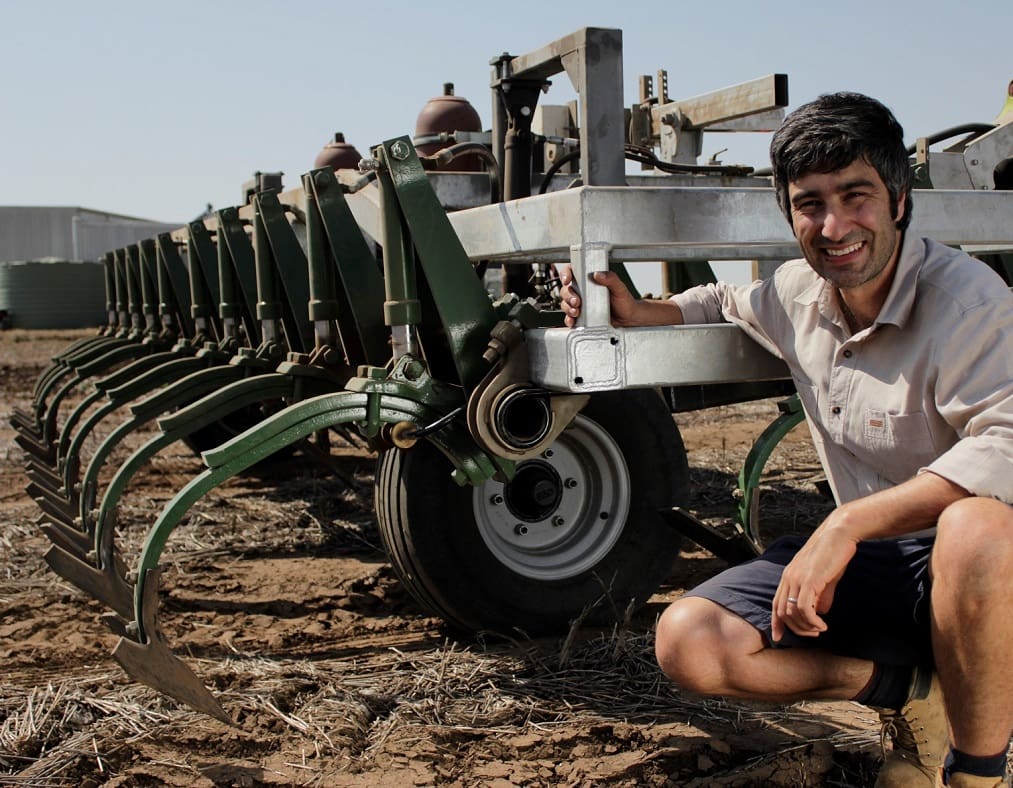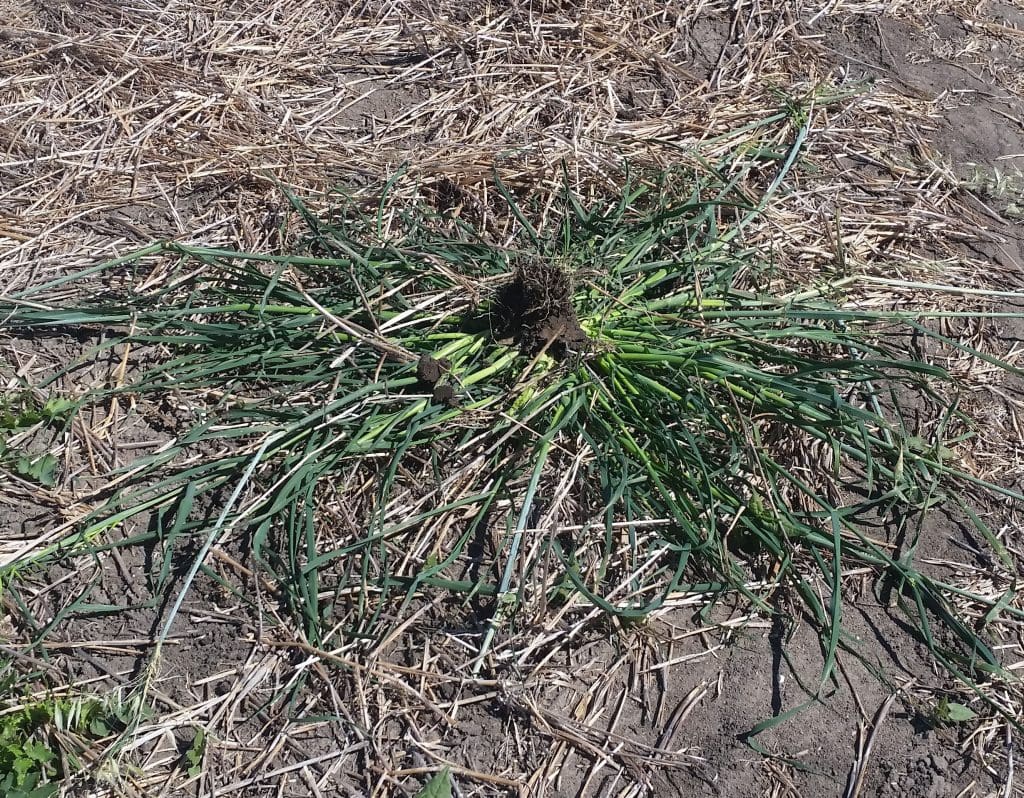
UWA agricultural engineer, Dr Andrew Guzzomi led the engineering component of a project to develop a tactical tillage machine, that can help manage herbicide resistance risk in conservation cropping fallow management. (Photo: Ryan Early, Anvil Media)
Ask a WeedSmart Expert
There’s nothing more old school than a chipping hoe when it comes to weed control. Chipping has so many practical benefits – simple, low tech, no survivors, cheap, environmentally friendly, non-chemical, works on all weed species and sizes and keeps the kids out of the house for hours.
The downside of course is that it is slow, hot, boring work and requires teams of people to make any difference to weed numbers. So, how good would it be to have multiple chipping hoes mounted on a bar travelling at 10 kilometres/hour and poised at the ready to chip out any weeds?
To see if this was feasible, the Grains Research and Development Corporation (GRDC) funded a project for an expert team* of agricultural engineers and weeds researchers, along with grower and industry advisers, to build and test prototypes in various cropping areas around Australia.
Their efforts have culminated in the development of the ‘Weed Chipper’, a cultivator fitted with hydraulic response tynes and commercially-available optical sensors that is ready for commercial trials and validation.
University of Western Australia School of Engineering agricultural engineer and senior lecturer, Dr Andrew Guzzomi, led the engineering development of the rapid response tyne, which was based on the Shearer Trashworker hydraulic breakout system.
“Like the optical sprayers, the ‘Weed Chipper’ is fitted with commercially-available optical sensors that can detect weeds and trigger individual tynes to rapidly chip out the weeds,” Dr Guzzomi said.
“Its best fit is in fallow situations where the weed density is low – around one weed per 10 square metres.
“Being well-suited to the control of larger weeds, this machine provides a fantastic non-chemical option to clean up survivors in a double-knock operation within a conservation cropping system.”
This machine has the potential to revolutionise herbicide resistant weed management and help farmers keep weed numbers low.
Field trials showed the implement is a highly effective way to manage key summer weed species, such as windmill grass, feathertop Rhodes grass and awnless barnyard grass, even when these weeds are up to 70 centimetres in diameter.
Any tactic that can consistently achieve 90 to 100 per cent weed control needs to be taken seriously.

The ‘Weed Chipper’ is a highly effective way to manage key summer and winter fallow weed species, such as windmill grass, feathertop Rhodes grass, awnless barnyard grass and wild oats, even when these weeds are up to 70cm in diameter.
How much damage does the chipping do to the soil in a no-till system?
Short answer: Very little at low weed densities.
Longer answer: Targeted tillage is suitable for use at low weed densities (i.e. 1 plant per 10 m2 or less). At low weed densities the ‘Weed Chipper’ disturbs only a very small portion of the paddock’s surface during weed control. The response tyne is designed so that the amount of soil disturbance can be altered as required to control the target weeds. The cultivation depth and duration can be increased to target large tap-rooted and fibrous weed species, or reduced for smaller, shallow-rooted species.
How fast does it operate?
Short answer: The ‘Weed Chipper’ has been developed to operate at a ground speed of around 10 km/h.
Longer answer: The response tyne system was designed to operate at a nominal 10 km/h where weed densities are 1 plant per 10 m2 or less. Although higher operational speeds are possible, this would increase system loads and the potential for misses of targeted weeds. With less environmental limitations impacting on safe operation, the ‘Weed Chipper’ can be operated 24/7 if necessary.
What is the best-fit for an optical chipper in an integrated weed control program?
Short answer: As a non-herbicide fallow weed treatment option in low weed density situations.
Longer answer: The best-fit for the ‘Weed Chipper’ is to target low density (1 plant per 10 m2) weed populations in fallow paddocks – the same situation where optical sprayers are currently being used. This will remove survivors and reduce weed seed-set, to potentially prevent or delay resistance evolution. The Weed Chipper also has the benefit of being able to be used across a range of environmental conditions that prevent the application of herbicide treatments. This facilitates more timely and effective weed control.
Source: WeedSmart
……………………………..
How to ask a WeedSmart question
Ask your questions about mechanical weed control on the WeedSmart Innovations Facebook page WeedSmartAU, Twitter @WeedSmartAU or the WeedSmart website www.weedsmart.org.au/category/ask-an-expert/
‘WeedSmart’ is an industry-led initiative that aims to enhance on-farm practices and promote the long term, sustainable use of herbicides in Australian agriculture.
* The Weed Chipper team led by Dr Michael Walsh (University of Sydney) is comprised of agricultural engineers Dr Andrew Guzzomi (UWA) and Dr Carlo Peressini (formerly UWA) and weed researchers Dr Michael Widderick (QDAF), Dr Adam McKiernan (QDAF) and Dr Bhagirath Chauhan (UQ).



Hi Andrew and Michael , I speculate that this Weed chipper machine could be used in row crops of 1 MT row spacing or single skip or 2 in and 2 out in cotton Dryland blocks. With the optical sensors sensitivity in use now , could you adapt this machine to those planting configurations above .
That would really take the pressure off Roundup Ready spray events and escapes.